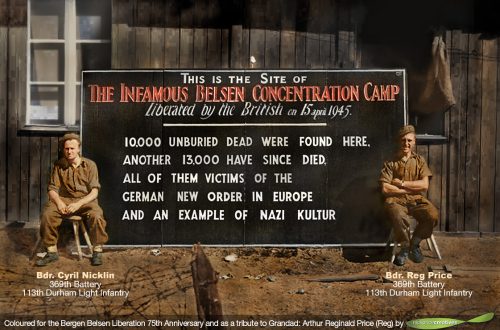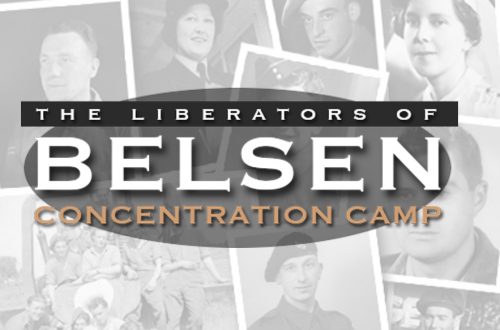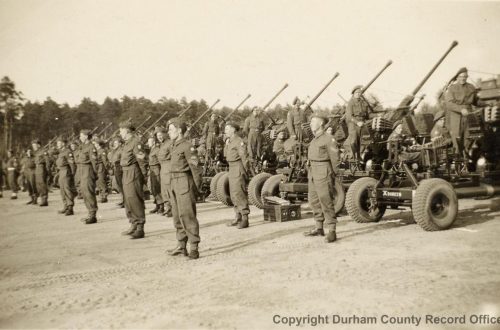The Story of Belsen – Capt. Andrew Pares
This account of events which took place at Belsen Concentration Camp between 13 April and 21 May 1945 has been written in response to general request expressed by members of 113 Light A.A. Regiment, RA, TA., late 2nd/5th Battalion The Durham Light Infantry and also of members of other units of 100 A.A. Brigade. It is written by the Adjutant, Captain Andrew Pares.
THE TRUCE.
On 12 April 1945 following the break-through of Second Army after the Rhine crossing, the German Military Commander at BERGEN-BELSEN (Chief of Staff 1 Para Army) approached 8 Corps with a view to negotiating a truce and avoiding a battle in the area of Belsen Concentration Camp.
In occupation of the area were 800 Wehrmacht, 1,500 Hungarians with their wives and families, and certain SS Prison Guards. In the Concentration Camp were known to be 45-55,000 internees of whom a very large number were reported to be suffering from Typhus, Typhoid, Tuberculosis and Gastro-Enteritis. The electricity and water supply had failed: there was no bread and very little food.
The Camp area consisted of the Concentration Camp and ½ mile North a large Tank Training Centre with very extensive barrack buildings, a small PW camp attached in which were 800 Russians, and a Military Hospital.
In the interests of our own troops and the internees, and from the point of view of preventing, the spread of disease, a truce was granted on the following terms.
The German Military Authorities were to erect notices and white flags at all the road entrances, marked ‘Danger – Typhus’ on one side and ‘End of Typhus Area’ on the reverse, with a disarmed German post at each notice. German and Hungarian troops would remain at their posts armed, wearing a white arm-band on the left sleeve. The Hungarians would remain indefinitely and were placed at the disposal of the British for such duties as might be required. The Wehrmacht were to be released within 6 days and conveyed back to the German lines with their arms, equipyment and vehicles. SS Guard personnel were to be removed by 1200 hrs 13 April and any remaining to be treated as PWs. SS Admin personnel would (if the Wehrmacht could prevent them running away) remain at their posts, carry on with their duties, and hand over records. When their services could be dispensed with, their disposal was left by the Wehrmacht to the British authorities, i.e. the Wehrmacht ‘sold’ the S.S.
THE TASK.
About 50% of the inmates were in need of immediate hospital treatment. All of them had been without any food for 7 days, and prior to that living on the normal concentration camp semi-starvation scale of diet.
There were about 10,000 typhus-infected bodies, mostly naked and many in an advanced stage of decomposition, lying around the camp, both inside and outside the huts, which required immediate burial; and the daily death rate was 4/500.
The living conditions were appalling – people were sleeping 3 in a bed, mainly treble-bunk beds, and huts which would normally accommodate 60 were housing 600. There were no sanitary arrangements, and both inside and outside the huts was an almost continuous carpet of dead bodies, human excreta, rags, and filth.
There were some 50,000 persons to supply and feed, but the cooking facilities were totally inadequate. There were 5 cookhouses of varying size equipped with a number of large boilers, and the only containers available to distribute the food were a few large dustbins A large proportion of the occupants were bed-ridden, and many were incapable even of feeding themselves.
The inmates had lost all self-respect and been degraded morally to the level of beasts. Their clothes were in rags and teeming with lice; they had no eating utensils or plates, and at the time of the food distribution they behaved more like ravenous wolves than human beings.
There were 49 SS male and 26 female prison guards under close arrest and a Wehrmacht Hospital with 2,000 sick and convalescent German soldiers.
The electricity which came from Celle was cut off and the wiring sabotaged; the water supply which depended on it for pumping had consequently failed.
To prevent spread of Typhus and the other diseases it was necessary to keep all the internees within the Camp, yet the Hungarian guards were grossly lax and made little effort to prevent them from filtering out.
THE PLAN
The plan was to create in the Tank Training School Barracks a vast hospital area for the sick under RAMC control, and to evacuate all the fit there, where they could be sorted out in big reception areas into national groups by sexes, and could also spend a quarantine period of about 3 weeks before repatriation.
THE WORKERS
The whole administration of the Camp was controlled by 10 Garrison and later by 102 Control Section. In support was 113 LAA Regt RA with its REME Workshops and 1575 Artillery Platoon RASC for general duties. The medical area was administered by 32CCS with 11 Field Ambulance and later 9 (Br) General Hospital and 35CCS, with 107 Mobile Laundry and a host of small RAMC and specialist units. 224, 618, and 904 Military Government Detachments divided themselves between the Concentration and Reception Camp. There were also 6 detachments of the British Red Cross Society and 100 medical students volunteers from the London Hospitals.
THE WORK
32 CCS with the aid of 11 Fd Amb, the British Red Cross, and the other RAMC specialists created a Hospital Area from empty barrack buildings and installed in it 7/8,000 patients in 3 weeks. They also organised a ‘human laundry’ for the disinfestation and bathing of all persons evacuated from the Concentration Camp. Within 7 days of their arrival they carried out a complete disinfestation with anti-louse powder (AL 63) of all the internees in all camps. 9 Br Gen Hosp took over the Wehrmacht Hospital, created their own hospital block from empty barrack rooms, and ran a maternity home.
Military Government in 4 weeks evacuated every single sick person from the Concentration Camp to the Reception Area, registered and reclothed them, and despatched over 15,000 on the route for repatriation. They obtained all the necessary food in accordance with the medical diet ordered, and arranged the requisition from the district of all stores and supplies needed for the Camp.
The RA set up special organisations to deal with burials. Between 19-26 Apr 9,200 bodies were buried in the communal pits and over the whole period 15,000 were buried – the highest figure was 1,700 on 21 Apr. All graves were decently enclosed, funeral services read daily, and notice boards stating the date and number in the grave were erected.
Large food-stocks uncovered in the Wehrmacht barracks were immediately impounded and delivered to the Concentration Camp. In addition a dump of tentage was transported to the camp and pitched to relieve the overcrowding.
Each cookhouse was made the personal responsibility of an RA Officer or Warrant Officer. At the beginning messing strengths averaged 10,000 to each cookhouse, and in one case 16,000. A Central Messing Office was set up under an RA officer to co-ordinate the distribution of rations and equipment and the re-allocation of cooks as evacuation occurred. An invalid cookhouse was established to prepare a special Bengal Famine Diet for the very sick, which was delivered round the huts for the medical students to administer to those who could not feed themselves.
An Inquiry Bureau was opened by the Padres to deal with the host of inquiries from the internees, to supply them with comforts and writing material, and censor and forward their letters. The RA took over the prison where first the SS Prison Guards were housed, and later Wehrmacht POWs who were employed on burial duties in both camps. RA personnel supervised and guarded daily large working parties of Hungarians, German POWs and civilians throughout the area, whose main duties were to clear all the barrack blocks, clean them out and refit them with beds etc either as Hospital or Reception Areas for the evacuated internees.
All the electricians and fitters in the REME Workshops were organised into a team, and repaired the electricity and restored the water supply. They also repaired the plant in the Camp Bakery and the other electrical apparatus in the Supply Depot so that the bakery was able to meet all the requirements of the Camp for bread.
The RASC Artillery Platoon undertook the task of co-ordinating all transport details, and in addition to their Regimental duties they drew all the supplies for everyone in the Camp, including rations and petrol. They supplied lorries for collecting food, clothes, beds, soap and all types of stores from the surrounding districts. With the aid of the RA butchers their supply section broke down the rations for every individual unit in the Camp including the Russian Battalion of 850 men.
Ablution benches, water points, and latrines were set up under the direction of the Field Hygiene Section, and while these were being made or during the periodical failures of the electricity, all the RA water-carts toured the area continuously, bringing water to the cook-houses, huts and barrack blocks.
The Russian PWs were organised by 10 Garrison into a Battalion with their own officers, equipped with rifles, issued with British Army rations, and eventually they superseded the Hungarians on the Camp Guard.
A Maternity Home and Children’s Ward were set up under 32CCS and later 9 Gen Hospital. A cot was made for each child by RA joiners, complete with blankets and waterproof sheets. Toys were impounded from the neighbouring towns, and swings were built for the playground. It is worthy of note that a very high percentage of the babies born were suffering from congenital venereal disease.
Reception Offices were set up by the RA under the auspices of 904 and 618 Mil Gov Detachments to assist in allocation of accommodation, registration and clothing of the evacuees, and responsible for administration of cookhouses and control of labour. In one Camp where no cookhouses were available, a wooden building was erected by RA labour and equipped to feed 4,000 in the space of 5 days.
Numerous guards were provided from time to time at the gates, Garrison HQ, Cinema, the DID and Supply Depot and in every cook house. Mobile jeep patrols toured the area continuously throughout the night to prevent looting, etc.
Two troops of RA worked exclusively under the Medical authorities, one at the Wehrmacht Hospital and the other in the Hospital Area, which they completely wired off and guarded to prevent unauthorised movement in and out.
The Concentration Camp was burned down hut by hut under RA supervision, and on 21 May 45 the last hut was burned to the ground.
BELSENS’ PURPOSE
Belsen was a Krankenlager or ‘Sick Camp’. It was not in any sense a hospital camp nor do prisoners seem to have been intended to recover. In the other Concentration Camps it was openly stated by their Commandants that anyone who went to Belsen would not come back; among their inmates a transport to Belsen was regarded as the last journey. Although the Camp has been established before the War, no witnesses have been found who have been there longer than 8/9 months and the majority have only been in the Camp for 3/4 months. There was no gas chamber as at the even more infamous camp at Auschwitz, where according to numerous testimonies hundreds of thousands were done to death by this means. Starvation, disease, and physical degradation were the lethal weapons employed at Belsen. It would appear that the purpose of Concentration Camps was to eliminate whole sections of the population. Two limiting factors deterred the Germans from doing this immediately on arrival of the prisoners. First, they wished to benefit by having in their power hostages for the good conduct of those left behind. Second, immediate destruction would have stimulated much greater resistance. It is quite clear that what took place in all the Concentration Camps was not intended to be mere incarceration, but was destruction either immediate or delayed.
THE ATROCITIES
The following are some of the facts which are corroborated by many witnesses.
The daily diet in a Concentration Camp was 3 pints of swede soup and 200/250 grammes of black bread.
Each day at 0300 hrs Roll-call was held, regularly lasting for 4/5 hours and often longer. Those able to stand were forced to drag out the sick and the dying.
In Feb, Mar & Apr 45 numerous cases of cannibalism of dead bodies are vouched for by many witnesses.
SS men and women guards beat and flogged the internees persistently at the slightest provocation. Most cases reported were for petty theft of food from cookhouses, or for failure to carry out quick enough the heavy tasks ordered. Similarly indiscriminate shooting of prisoners was a normal occurrence.
Beside the entrance to the Crematorium was a pile of boots removed from the bodies before incineration: it stood 12ft high and covered an area 36ft x 18ft, and must have been composed of hundreds of thousand pairs.
The Register of deaths show that about 17,000 died during the month of Mar 45, and for some time previously the average monthly death rate was 25% of the total.
A British Royal Marine who was left behind after a raid on the coast of Norway and fell into the hands of the Gestapo was murdered on 28 Mar 45 by order of one of the SS guards, which is confirmed by several witnesses.
A certain number of internees were found who had been subjected to medical experiments or compulsory sterilisation.
A team of War Crimes Investigation Dept examiners have been accumulating evidence in the Camp over the past month.
13 Apr
Application by Germans to 8 Corps for truce.
15 Apr
63 A/Tk Regt HQ and 1 Bty and 1 Tp LAA entered the Camp.
17 Apr
32 CCS and 11 Fd Amb arrived – 224 Mil Gov Det arrived.
BGS 8 Corps ordered arrest and disarming of all SS personnel.
18 Apr
10 Garrison took over comd of the Camp.
113 LAA Regt RA arrived, having covered 238 miles in 22 hours.
19 Apr
113 LAA Regt relieved 63 A/Tk Regt.
369 Bty took over Concentration Camp.
370 Bty took over male Reception Camp, prison and guard duties.
20 Apr
10 FW 190s machine-gunned 32 CCS at dawn.
1575 Arty Pl RASC took over all supplies for the Camp.
800 Wehrmacht prisoners escorted through the German lines in accordance with the terms of the truce.
21 Apr
368 Bty took over the Arsenal, the female Reception Camp, the Mil Hosp and work in the Hospital area.
113 RHQ and REME Workshops established in the Barracks.
23 Apr
6 dets of British Red Cross Society arrived.
29 Apr
102 Control Section relieved 10 Garrison.
All SS prisoners transferred to CELLE gaol.
30 Apr
100 volunteer medical students arrived by air from UK.
4 May
9 Br Gen Hosp arrived.
All Wehrmacht patients evacuated from Mil Hosp.
5 May Hostilities on 21 Army Group front ceased.
Russian Battalion relieved Hungarian guards.
8 May
VE Day – March-past and Victory salvo fired by guns.
14 May
New Reception Camp opened in Officers’ living quarters.
First Reception Camp evacuated and taken over by 9 Br Gen Hosp as new hospital area.
15 May
Russian Battalion left for repatriation.
19 May
Evacuation of Concentration Camp completed.
21 May Last hut of Concentration Camp burnt to the ground.
9,689 total views




